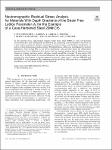Item Infomation
Full metadata record
| DC Field | Value | Language |
|---|---|---|
| dc.contributor.author | Pulvermacher, S. | - |
| dc.contributor.author | Šaroun, J. | - |
| dc.contributor.author | Cabeza, S. | - |
| dc.date.accessioned | 2023-08-18T02:20:10Z | - |
| dc.date.available | 2023-08-18T02:20:10Z | - |
| dc.date.issued | 2023 | - |
| dc.identifier.uri | https://link.springer.com/article/10.1007/s11661-023-07076-y | - |
| dc.identifier.uri | https://dlib.phenikaa-uni.edu.vn/handle/PNK/8829 | - |
| dc.description | CC-BY | vi |
| dc.description.abstract | In the present work, ring-shaped samples made from steel 20MnCr5 were low-pressure carburized (LPC) and subsequently hardened by gas quenching (case-hardened). This results in a near-surface gradient in chemical composition, microstructure- and hardness distribution, as well as a three-dimensional residual stress (RS) distribution, which was investigated by neutron diffraction. Near-surface RSs in the ferrite-/martensite- and austenite phase are additionally determined by X-ray diffraction. It is shown that the chemical gradient has an influence on the chosen d0 strategy and how such a reference sample should be extracted. If near-surface RS values are to be determined by neutron diffraction, the pseudo-strain effect must be taken into account. For this purpose, a suitable approach using the “open source” software SIMRES and STRESSFIT is also presented. By combining neutron and X-ray diffraction data, a complete RS distribution over the whole sample can be obtained. | vi |
| dc.language.iso | en | vi |
| dc.publisher | Springer | vi |
| dc.subject | LPC | vi |
| dc.subject | RS | vi |
| dc.title | Neutronographic Residual Stress Analysis for Materials With Depth Gradients of the Strain Free Lattice Parameter d0 for the Example of a Case-Hardened Steel 20MnCr5 | vi |
| dc.type | Book | vi |
| Appears in Collections | ||
| OER - Khoa học Vật liệu, Ứng dụng | ||
Files in This Item:

